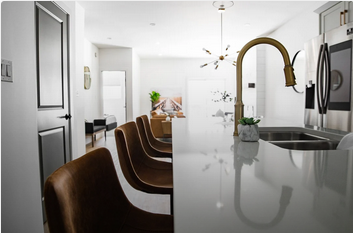
Kitchen Extensions
The rise of the kitchen at the heart of the house creates a very liveable home and a kitchen/dining/living space is easy to create with the rear extension.
A rear extension up to 8 metres (for a detached house)/6 meters (for a semi-detached/terraced house) from the original rear of the property can be typically achieved via Permitted Development. However, larger single-storey rear extensions are subject to the Neighbour Consultation Scheme.
How much does a kitchen extension cost?
The main governing factor of the cost of an extension is square footage or square meterage – how big it is. So, the bigger it is, the more it’s going to cost.

Typically if you worked out a square meter at £1500, that’s a good base price for basic quality; £1900 per square meter for good quality and £2200 per square meter for excellent quality.
For an average single storey extension of 20 square metres, the build cost would be from £30,000 for basic quality, from £38,000 for good quality and from £44,000 for excellent quality.
Bi-fold or Sliding Doors
Budget from £1,500 to £2,000 per linear metre
In addition to the build cost of the extension, are the interior fit-out costs. For a kitchen, you should budget from £7,000 to £15,000. The biggest cost factor is the appliances – the better the appliances, the higher the cost.
A single storey extension of 20 square metres of basic quality, will cost a minimum of £44,000 including most fees, but excluding interior fit-out costs.
- Yoop Architects TWEET THIS
Interior Fit-Out Costs
- Lighting
- Heating
- Flooring
- Painting/Tiling
Fixtures & Fittings
- Kitchen units – Budget from £350 per unit
- Cabinet doors and drawers
- Kitchen worktops
- Laminate – Budget from £50 per square metre
- Granite – Budget from £200 per square metre
- Stainless steel – Budget from £250 per square metre
- Marble, Quartz, composite stone – Budget from £350 per square metre
Appliances
- Oven / Range
- Hob
- Hood / Extractor
- Microwave
- Fridge / Freezer
- Sink and Tap
- Dishwasher
- Washing Machine / Tumble Dryer
Inside this easy to read free guide, discover how to design your home extension.
You’ll also need to take into consideration professional, permission and agreement fees depending on your property and what you are planning.
Additional Costs
- Professional Fees (builders, architects, tradesmen)
An extension of 20 square metres at a build cost of £30,000 could potentially attract professional fees from £12,000 - Permission Fees (planning permission £206 /permitted development £103)
- Other (insurance, shared drains/walls, building regulations approval or specific environmental/ecological reports for your property)
All together, it’s worth setting aside at least £2,000 to cover any fees for permissions and sign off
A single storey extension of 20 square metres of basic quality, will cost a minimum of £44,000 including most fees, but excluding interior fit-out costs.

To calculate the cost of your extension, Yoop Architects take a measured survey of your property, which captures all the information. Then we draw it all up in 3D and create sketches to show sometimes five or six options if it’s not entirely clear how you want to achieve your brief.
A lot of the times there are different ways of achieving your desired result and the more you work with the building, the cheaper, easier and faster your build will be. Once you’ve got a favorite scheme or a couple of favorite schemes, we have a phase called ‘Meet the Builders’. That’s when we can introduce you to a couple of builders, they visit the property and they give you a ballpark figure.
FREE EXPERT HELP TODAY
Thinking of your dream home improvement or how to start your project?
Need your planning questions answered? Talk to an expert today.
Book a FREE 20 Minute Call with one of our home improvement Architects.


